






This lesson explains the need for specialised exchange surfaces and uses examples to describe the features of an efficient exchange surface. The PowerPoint and accompanying worksheets have been designed to cover points 3.1.1 (a & b) of the OCR A-level Biology A specification and also have been specifically planned to prepare the students for the upcoming lessons in module 3 on gas exchange and mass transport in animals.
The students are likely to have been introduced to the surface area to volume ratio at GCSE, but understanding of its relevance tends to be mixed. Therefore, real life examples are included throughout the lesson that emphasise the importance of this ratio in order to increase this relevance. A lot of students worry about the maths calculations that are associated with this topic so a step by step guide is included at the start of the lesson that walks them through the calculation of the surface area, the volume and then the ratio. Through worked examples and understanding checks, SA/V ratios are calculated for cubes of increasing side length and living organisms of different size. These comparative values will enable the students to conclude that the larger the organism or structure, the lower the surface area to volume ratio. A differentiated task is then used to challenge the students to explain the relationship between the ratio and the metabolic demands of a single-celled and multicellular organisms and this leads into the next part of the lesson, where the adaptations of large organisms to increase this ratio at the exchange surfaces are covered. The students will calculate the SA/V ratio of a human alveolus (using the surface area and volume formulae for a sphere) and will see the significant increase that results from the folding of the membranes. In addition to the ratio, time is taken to discuss and describe how the maintenance of a steep concentration gradient and a thin membrane are important for the rate of diffusion and again biological examples are used in humans and other organisms to increase the understanding. Fick’s law of diffusion is also introduced as a mechanism to help the students to recall that surface area, concentration difference and thickness of membrane govern the rate of simple diffusion.
As well as making links to upcoming topics, prior knowledge checks are used to challenge the students on their knowledge of previously-covered modules which include inorganic ions, organelles, cell membrane transport and tissues.
Get this resource as part of a bundle and save up to 33%
A bundle is a package of resources grouped together to teach a particular topic, or a series of lessons, in one place.
Module 3: Exchange and transport (OCR A-level Biology A)
This bundle contains 18 detailed and engaging lessons which cover the following specification points in module 3 (Exchange and transport) of the OCR A-level Biology A specification: 3.1.1: Exchange surfaces * The need for specialised exchange surfaces * The features of an efficient exchange surface * The structures and functions of the components of the mammalian gaseous exchange system * The mechanism of ventilation in mammals * The mechanisms of ventilation and gas exchange in bony fish and insects 3.1.2: Transport in animals * The double, closed circulatory system in mammals * The structure and functions of arteries, arterioles, capillaries, venules and veins * The formation of tissue fluid from plasma * The external and internal structure of the heart * The cardiac cycle * How heart action is initiated and coordinated * The use and interpretation of ECG traces * The role of haemoglobin in transporting oxygen and carbon dioxide * The oxygen dissociation curve for foetal and adult haemoglobin 3.1.3: Transport in plants * The structure and function of the vascular systems in the roots, stems and leaves * The transport of water into the plant, through the plant and to the air surrounding the leaves * The mechanism of translocation As well as the detailed A-level Biology content of the PowerPoint slides, the resources contain a wide range of tasks including guided discussion points, exam-style questions and quiz competitions which will engage and motivate the students
Module 3.1.1: Exchange surfaces (OCR A-level Biology A)
This lesson bundle contains 5 lesson PowerPoints and together with their accompanying worksheets, they will engage and motivate the students whilst covering the following specification points in module 3.1.1 (Exchange surfaces) of the OCR A-level Biology A specification: * The need for specialised exchange surfaces * The features of an efficient exchange surface * The structures and functions of the components of the mammalian gaseous exchange system * The mechanism of ventilation in mammals * The mechanisms of ventilation and gas exchange in bony fish and insects Found interspersed within the detailed A-level Biology content in the slides are current understanding and prior knowledge checks and these are followed by displayed mark schemes to allow students to assess their progress. There are also differentiated tasks, guided discussion periods and quiz competitions that introduce key values and terms in a fun and memorable way If you would like to see the quality of lessons included in this bundle, then download the mammalian gaseous exchange system and ventilation and gas exchange in insects lessons as these have been uploaded for free
Something went wrong, please try again later.
This resource hasn't been reviewed yet
To ensure quality for our reviews, only customers who have purchased this resource can review it
Report this resourceto let us know if it violates our terms and conditions.
Our customer service team will review your report and will be in touch.